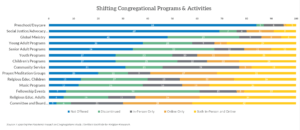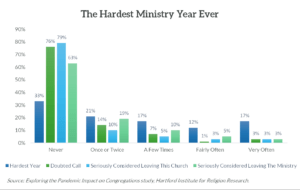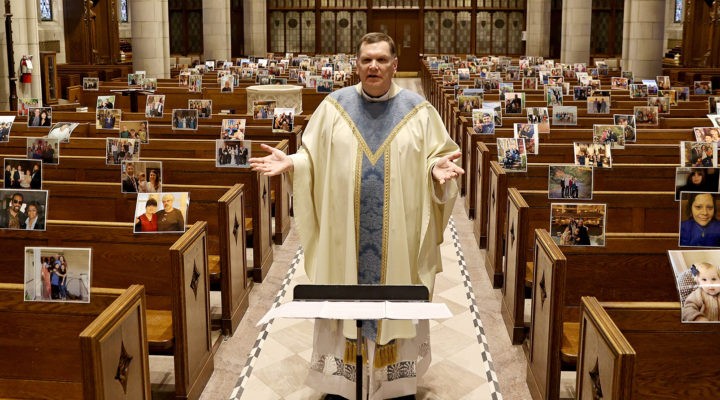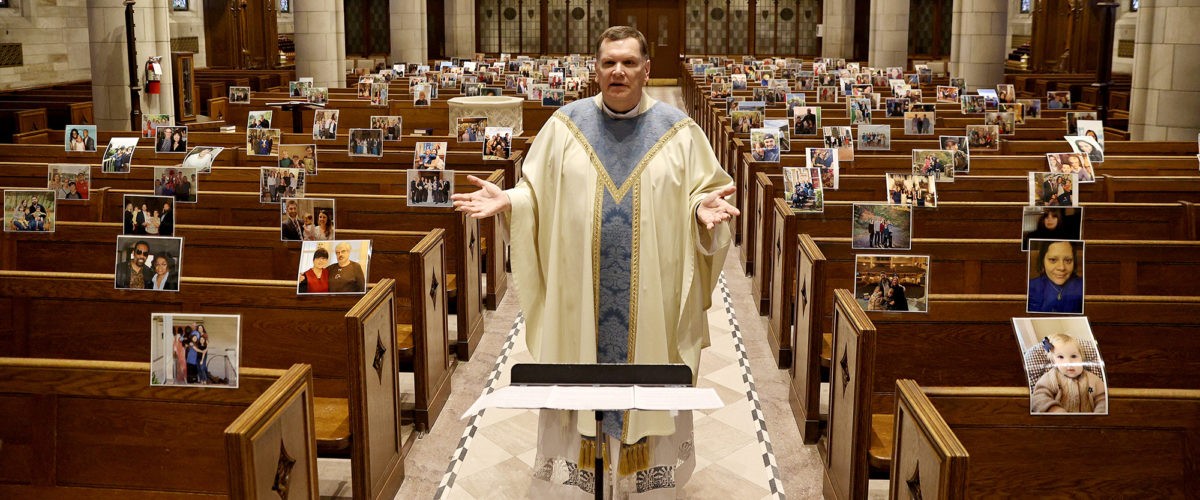The COVID-19 pandemic has accelerated the decline facing most congregations in America, but the effects are not evenly distributed among all churches, according to the most comprehensive study to date of the pandemic and congregational life.
The “Exploring the Pandemic Impact on Congregations” study is a collaborative venture of 13 denominations from the Faith Communities Today partnership and Hartford Institute for Religion Research. Its data are drawn from the 13 denominational groups and a random sampling of congregations in other denominations for a total of 38 Christian denominational groups.
The online survey was conducted from mid-June to the end of August 2021 — spanning the time when many churches first began to reopen through the rise of the Delta variant that caused renewed caution nationwide.
“As much as we would like to have definitive answers regarding the impact of the pandemic on congregational life in the United States … there remains a lot of uncertainty.”
“As much as we would like to have definitive answers regarding the impact of the pandemic on congregational life in the United States, and even with some people and organizations claiming to have definitive answers, there remains a lot of uncertainty,” the report’s authors said.
Part of that uncertainty is represented by the uneven effects of the pandemic on congregational life. While many churches have experienced decreased participation even after reopening, other churches have grown.
Less caution equals greater growth
One key finding is that congregations that were the least cautious and were the most likely to experience infections and deaths of members through the pandemic also are the most likely to report growth. On the flip side, congregations that were the most cautious and least likely to return to in-person worship are the most likely to report decline.
 Andrew Gardner, a BNG columnist who currently serves as a fellow with the Hartford Institute for Religion Research, said in an interview that he sees more nuance in this point.
Andrew Gardner, a BNG columnist who currently serves as a fellow with the Hartford Institute for Religion Research, said in an interview that he sees more nuance in this point.
“The congregations that were the least willing to change tended to be smaller congregations who saw the most decline. The congregations that saw growth over the pandemic tended to be larger churches with hybrid modes of worship,” he said. “Cautiousness is hard to quantify. The most cautious churches I would consider to be those who are still only meeting online, and these congregations saw some decline but not nearly as much as congregations that are currently only meeting in person right now.”
The real factor related to growth is hybrid worship, he added. “There is still a segment of the population that is concerned about attending in-person services while there is also a segment of the population that wants to attend in-person services. Churches that can cater to both populations have been more likely to see growth.”
Far from normal
Overall, the study indicates that “congregational life is far from being ‘back to normal,’” the researchers explained. “This should not be surprising.”
Within the study period, 80% of U.S. congregations were found to offer a hybrid of in-person and online services, while only 15% of churches offered in-person worship only and 5% offered online only.
80% of U.S. congregations were found to offer a hybrid of in-person and online services.
Whether this strong preference for hybrid worship options — a significant change from before the pandemic — is a permanent change is not yet clear.
One of the statistical mirages that could be drawn from the study is to view only the national averages in attendance pre-pandemic versus today. This summer, churches reported median attendance for in-person worship of 45 with a median attendance for online worship of 20, for a total median attendance of 65. “This number correlates with the pre-pandemic data from the 2020 Faith Communities Today Survey that also found congregations had a median attendance of 65,” the authors explained. “Such a comparison would suggest congregational attendance has remained stable, but a closer look shows what most churches know — there has been a decline in congregational attendance, but it currently is not as severe as might be expected nor shared equally by all churches.”
Viewed another way, this year’s poll asked respondents what their church attendance was in 2019 compared to today. That question revealed a 12% decline overall in the past two years — on average.
“But not all churches are experiencing the pandemic equally,” the researchers noted. “In certain churches, decline is happening rapidly, while others are growing. Since 2019, 35% of churches reported a decline of 25% or more in attendance and another 22% of congregations reported a decline greater than 5% but less than 25%. Additionally, 15% of churches reported a relatively stable attendance in the past two years. Yet 28% of congregations reported growth in the past two years, with 18% of these reporting significant growths of over 25%.”
Accelerating an existing attendance trend
Once again, the pandemic appears to have accelerated an existing trend, as research before the pandemic showed a stark world of haves and have-nots where the nation’s largest churches were getting bigger despite the reality of most churches losing attendance. What has been true of the largest congregations in America has not been true of the “average” church in America.
Multiple other studies have confirmed this trend. While 90% of churches in America have fewer than 250 people in weekend attendance, 70% of American churchgoers attend churches with more than 250 people in attendance.
It now appears that the pandemic has added fuel this trend of big churches getting bigger as average and smaller churches grow smaller. Often, larger churches were more prepared to offer online services. And, the latest survey revealed, larger evangelical churches were more willing to take the risk of spreading infection in order to keep growing.

Hybrid approach a key to success
Regardless of church size, adapting to hybrid services was a key to survival during the pandemic, the study found. The steepest decline in attendance was reported among the 15% of congregations that said they offered only in-person worship. These churches on average experienced a 16% drop in attendance.
“These congregations tend to be smaller in size with older clergy, are the least willing to change, and had the most struggle to adapt,” the report stated. “These congregations represent 40% of Catholic/Orthodox, 8% of Mainline, and 7% of evangelical congregations.”
Likewise, offering only online worship also was not a key to sustaining or growing attendance during the pandemic. As of this summer, 5% of surveyed congregations said they continued to offer only online services — and that set of churches reported a 7% decline in attendance.
“These congregations tended to be more mid-sized with older clergy, are the most willing to change, and had the least struggle adapting to the pandemic,” the researchers said. “While these congregations reported the fewest COVID-19 infections, they also reported being the most worried or threatened by the pandemic. These congregations represent no Catholic/Orthodox, 30% of Mainline, and 3% of evangelical congregations.”
The only growth in attendance over the past two years has been among churches that offered both in-person and online worship as of this summer.
The only growth in attendance over the past two years has been among churches that offered both in-person and online worship as of this summer. That’s 80% of U.S. churches — although most of the churches among that group did not report growth. On average, however, these hybrid churches reported growth of 4.5%.
“These congregations tended to be larger with younger clergy, reporting moderate willingness to change, and expressing some struggles to adapt,” researchers explained. “They also reported the most infections of COVID-19 of staff and members, as well as the most congregational deaths. These congregations represent 60% of Catholic/Orthodox congregations, 62% of Mainline, and 90% of all evangelical congregations.”
Churches and the virus
The survey also asked church leaders how their congregations had been challenged medically by the pandemic. The vast majority (83%) of churches reported at least one member had tested positive for COVID, while only 17% said someone in the congregation had died from COVID.
Among church staff nationwide, 37% of churches reported a staff member tested positive for the virus and 2% said a staff member died from the virus.
As the nation has been embroiled in debates about vaccination and vaccine mandates, much of the doubt cast on the safety and effectiveness of COVID-19 vaccines has come from conservative evangelicals. Perhaps that’s why the new survey found 38% of clergy did not encourage congregants to get vaccinated. (In contrast 62% of clergy did encourage vaccination.)
The number of clergy not encouraging vaccination is highest among evangelical Protestants.
The number of clergy not encouraging vaccination is highest among evangelical Protestants. Among that group, only 41% said they had done so — the lowest representation of any group.
Among clergy from African American denominations, 100% have encouraged vaccinations, as have 77% of Mainline Protestant clergy and 49% of Catholic/Orthodox clergy. Within majority Latino churches from various denominations, 65% of clergy have encouraged vaccination.
Church conflict
Throughout the pandemic, horror stories about intensive church conflict have circulated both in news articles and in informal clergy networks. Church leaders have reported disputes about whether to require masks, whether to meet in-person, what the pastor has or hasn’t said from the pulpit and more.
And indeed, the new survey found only one-fourth (25%) of congregations reporting no conflict with regard to COVID safety measures. However, the majority (52%) reported only “mild” conflict. Another 17% reported “moderate” conflict and 7% reported “severe” conflict.
Church finances
One of the surprises found in this and other survey work related to the pandemic is that, on the whole, church finances have not suffered greatly due to the pandemic. In this survey, only 15% of congregations said they were forced to make staffing changes, which mainly meant laying off staff rather than decreasing hours.
This corresponds to other national surveys that have found surprising financial resilience among U.S. congregations during the pandemic.
In the new survey, 41% of congregations said their giving actually increased during the pandemic, while 30% reported a decline in giving.
Although church members may have been willing to keep sending their money to the church during the pandemic, they were not willing to keep volunteering. Surveyed congregations reported that only 15% of regularly participating adults now are volunteering, compared to 40% before the pandemic.
Researchers explained: “In the same way that supply chains have been drastically upended by the pandemic, so too have many congregational ministry systems been disrupted.”

Church programming
Most data and most discussion about congregational adaptations to the pandemic have focused on worship. But other areas of church programming have been affected more significantly than worship, because most churches have prioritized worship as the one thing they must continue.
The greatest losses have happened in church fellowship, and this was noted as a sad irony by researchers. “Throughout a pandemic when people around the country were experiencing severe isolation, over half of the churches (54%) reported completely discontinuing fellowship events, rather than moving this community-building practice online.”
In fact, among an array of church programming the survey asked about, the loss of fellowship events was by far the most common denominator. The share of churches discontinuing fellowship options is nearly double the share of churches discontinuing any other program. The next-closest impact was on discontinued senior adult programs (33%) and global ministries (29%)
What has been most likely to carry on in virtual formats is small-group meetings including committees, adult religious education, prayer and meditation groups.
The data about church fellowship, while alarming, should not be surprising, Gardner said.
“Fifty-four percent of congregations discontinued fellowship events because of the pandemic. That’s staggering,” he noted. “Going to church essentially became a bunch of tasks and things to do. Congregations discontinued events where the sole object was just to be in community with one another.
“No wonder many ministers thought the pandemic was the hardest period of their vocational careers. The pandemic has certainly made these events challenging, but I hope pastors will see this statistic and start thinking of ways to bring fellowship back into the communal life of their congregations.”

Clergy well-being
Another consistent narrative of the past 20 months has been the emotional and physical distress of clergy as they lead congregations through conflict and change. But again the reality is a mixed bag of haves and have-nots.
The new survey found that two-thirds of clergy (67%) have thought at least once in the past 12 months that this was the hardest year ever of their ministry, with 12% and 17% having this thought fairly or very often. But one-third of pastors said this was not their hardest year of ministry.
And despite documented reports of higher-than-usual clergy retirements and resignations, 76% of clergy said they never once doubted their calling or considered leaving their church during the past year. However, another 37% seriously considered leaving pastoral ministry at least once, and 20% reported having this thought once or twice. One in 10 clergy (10%) reported that a few times over the past year they seriously considered leaving pastoral ministry, and another 8% said they had thought about it fairly or very often.
“Perhaps clergy are continuing to mask their challenges and are wanting to put on a happy face.”
That clergy didn’t report as much emotional and physical distress as expected “was surprising for us too,” Gardner said. “There are a couple ways to think about this. Perhaps clergy are continuing to mask their challenges and are wanting to put on a happy face. Or it could be that clergy mental health is worse in specific denominational bodies than overall.
“On the other hand, clergy who have weathered the pandemic and its challenges well are not as likely to get as much media and press coverage as those who have really struggled to contend with all the many challenges the past nearly two years have thrown at them. This is something, however, we will be continuing to follow and track in the coming months and years.”
Looking ahead
Having sifted all the data, the research team at Hartford ends the report with a note of optimism.
“While certainly much of the data surrounding congregational attendance and the struggles churches are facing are grim, such data should not be surprising nor overblown at this point in congregational recovery efforts,” they wrote. “The COVID-19 pandemic has created the most drastic public health crisis the United States has experienced in a century, and it has coincided with one of the most politically polarized moments in decades. It makes sense that congregations are sharing in this struggle.”
Their prediction: “Attendance will continue below pre-pandemic levels for quite some time, but it is apparent in the data that hope is not lost and a solid percentage of churches are beginning to rebound and thrive. The true task facing pastors and lay leaders is that of reminding wayward members of the benefits of spiritual education, the joy of community, and the richness of fellowship with other believers. If they do this, it is quite likely that many parishioners will return, whether it is to in-person or online worship.”
Related articles:
Largest-ever U.S. congregational survey confirms what church consultants have been telling you
How will your church rebuild after the disaster of the past year and a half? | Opinion by Mark Wingfield


